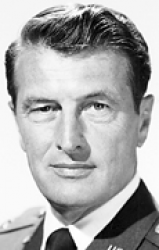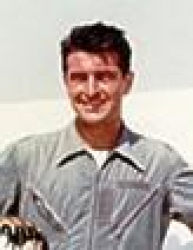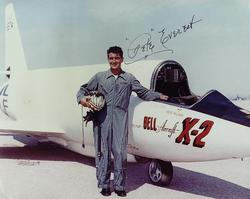
 |
|
|
||
|
Frank Everest 'Speedy Pete' |
||||
|
Engagements: • World War II (1941 - 1945) |
||||
| Biography: | ||||
|
Frank "Speedy Pete" Everest Frank Everest was born on 9 August 1920 in Fairmont, WV. After he graduated from Fairmont Senior High School in 1938, he attended Fairmont State College for one year. He later studied engineering at West Virginia University to prepare himself for a flying career. Military Career He entered the U.S. Army Air Forces aviation cadet pilot training on 11 November 1941; he graduated and received a commission as a Second Lieutenant on 3 July 1942. Among his classmates in Class 42-F was future European Theatre of Operations ace Robert S. Johnson. After Curtiss P-40 aircraft training, Everest was sent to North Africa and flew 94 combat missions in Africa, Sicily and Italy with the 314th Fighter Squadron, 324th Fighter Group. During that tour of duty, he shot down two German Ju-52 transports on 18 April 1943, and damaged another. In May 1944, he was assigned to a fighter squadron at Venice, FL, as an instructor. He asked for combat duty again and was assigned to the China-Burma-India Theater of Operations. There he was assigned to command the 17th Provisional Fighter Squadron, 5th Provisional Fighter Group of the Chinese-American Composite Wing at Chinkiang, China. This wing consisted of both USAAF and Republic of China pilots flying in mixed elements. He completed 67 combat missions and destroyed four Japanese aircraft before his P-51 Mustang was shot down by ground fire in May 1945. He bailed out deep behind Japanese lines where was captured and tortured as a Japanese prisoner of war before being repatriated at the end of hostilities. Following a rest leave, Everest was assigned to the Flight Test Division at Wright-Patterson AFB, OH, as a test pilot, in February 1946. He took part in many experimental tests of the Bell X-1 and established an unofficial world altitude record of 73,000 feet. In September 1951, he was transferred to the Air Force Flight Test Center at Edwards AFB, CA, and became the chief Air Force test pilot as head of the Flight Test Operations Division. During his stay at Edwards, Everest tested the X-1, 2, 3, 4 and 5; XF-92 and YB-52. He also took part in test programs for the F-88, 100, 101, 102, 104 and 105; the B-52, 57 and 66 aircraft. In all, during his ten years as a test pilot, Everest checked out 122 aircraft. On 29 October 1953, he established a world speed record of 755.149 mph in a YF-100. Everest test-flew the Bell X-1B to a speed of Mach 2.3 (2.3 times the speed of sound) in December 1954, making him the second fastest man in the world. Later flights in the Bell X-2 rocket plane established him as "the fastest man alive" when he attained a new unofficial speed record of 1,957 mph (Mach 2.9). He graduated from the Armed Forces Staff College at Norfolk, VA, in 1956. He was transferred to Hahn Air Base, Germany, in March 1957, as Commander of the 461st Fighter Squadron of the 36th Fighter Wing. He was assigned to North Africa in July 1958 as a Group Commander and later became Deputy for Operations at Wheelus Air Base, Libya. Upon returning to the U.S. in January 1961, he became Director of Operations, 401st Tactical Fighter Wing, England AFB, LA. Everest next commanded the 4453d Combat Crew Training Wing at MacDill AFB, FL, and in June 1964 he transferred with the Wing to Davis-Monthan AFB, AZ. In May 1965, he was transferred to Nellis AFB, NV, to become Commander of the 4520th Combat Crew Training Wing. In June 1966, Everest became Director of Aerospace Safety in the Office of the Deputy Inspector for Inspection and Safety, Norton AFB, CA. He was transferred to the Pentagon in January 1969 as Assistant Director (Operational Test and Evaluation), Office of the Director of Defense Research and Engineering. Everest assumed command of the Aerospace Rescue and Recovery Service of the Military Airlift Command at Scott AFB, IL, in April 1970. Effective 1 November 1965, Everest was promoted to the temporary grade of Brigadier General with date of rank from 29 October 1965. Everest's service-wide nickname was "Pete" and he retired from the Air Force in 1973. He was a Command Pilot with over 9,000 flying hours. He was also a graduate of the U.S. Army Parachutists School at Fort Benning, GA. Medals and Awards Legion of Merit (2 Awards) Badges and Insignia Command Pilot Badge Honors Everest was chosen as one of 1955s "Ten Outstanding Young Men" by the U.S. Junior Chamber of Commerce. In 1956 the U.S. Chamber of Commerce named him one of the nation's "Greatest Living Americans." In 1957, he was awarded both the Harmon Trophy and the Octave Chanute Award. In 1988, he won the Godfrey L. Cabot Award. He was inducted into the Aviation Hall of Fame in 1989. He was inducted into the Aerospace Walk of Honor in Lancaster, CA, in 1991. He was a member of the Arizona Aviation Hall of Fame's 1997 class, which also included Senator John McCain, a former Navy pilot. In 2009, Everest received the USAF Test Pilot School's Distinguished Alumnus Award from Class 08B. This award is presented bi-annually to a USAF TPS graduate who has made significant and lasting contributions to aviation science and the flight test community. Death Brigadier General Frank Everest died on 1 October 2004 at his home in Tucson, AZ. His burial location is unknown. |
||||
| Honoree ID: 2480 | Created by: MHOH | |||
Ribbons
Medals
Badges
Honoree Photos
 |  |  |
 |  |
 |


